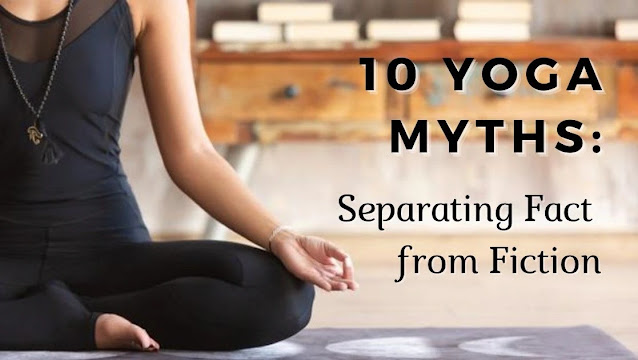Are you curious about yoga but hesitant to try it because of all the myths you’ve heard? It’s important to separate fact from fiction when it comes to any new activity; yoga is no exception. This blog post will debunk 10 common yoga myths to help you better understand the practice and decide whether it’s right for you.
Yoga is an ancient practice that has been gaining popularity in recent years. It’s a holistic health and wellness approach involving physical postures, breathing techniques, and meditation. While yoga has many benefits, it’s also surrounded by many misconceptions. From the idea that you need to be flexible to start to the belief that it’s only for women or young people, many myths can discourage people from trying yoga.
The truth is yoga is a practice that can be adapted to suit people of all ages, body types, and fitness levels. It can be used for relaxation, stress relief, and physical fitness, and it’s not a religion. In this blog post, we’ll take a closer look at these and other common yoga myths to help you understand the practice better and make an informed decision about whether it’s right for you.
Yoga Myth #1: You Have to be Flexible to Start
Yoga is a practice to help you become more flexible, not the other way around. Many people believe they need to be flexible to start yoga, but this is not true. Yoga is a practice that can be adapted to suit your current level of flexibility and can help you become more flexible over time.
It’s important to remember that everyone has different starting points, and you should not compare yourself to others in the class. Yoga is a practice that is meant to be done at your own pace, and it’s essential to listen to your body and work with a qualified teacher who can help you modify poses to suit your current level of flexibility.
One tip for beginners is to start with a gentle or restorative yoga class, focusing more on stretching and relaxation than challenging poses. It will help you build the foundation to move to more advanced classes. And remember, yoga is a practice, and it takes time and patience to see progress. Be kind to yourself, and don’t compare yourself to others in the class.
Another tip for beginners is to use props such as blocks, straps, or blankets to help them modify poses and reach the ground. It will help you develop the strength and flexibility you need to do the poses without the props.
Yoga Myth #2: Yoga is Only for Women
Another common yoga myth is that it is only for women. It couldn’t be further from the truth! Men and women have practiced yoga for centuries, which has been proven to benefit both genders.
The history of yoga is rooted in ancient India, where men and women alike have been practicing it for thousands of years. In recent times, yoga has become increasingly popular in Western cultures and embraced by people of all genders, ages, and backgrounds.
Yoga is a holistic practice that can benefit both men and women equally, from improving flexibility and strength to reducing stress and anxiety to promoting overall well-being. Men who practice yoga have reported better balance, improved athletic performance, and reduced risk of injury.
Yoga is not limited to one specific group of people. It can be enjoyed by everyone regardless of their gender. And different styles of yoga can cater to different needs, such as power yoga for strength or restorative yoga for relaxation. So, don’t be discouraged by the myth that yoga is only for women. Give it a try and see how it can benefit you, too!
Yoga Myth #3: Yoga is Only for Relaxation and Stress Relief
One of the most popular misconceptions about yoga is that it’s only for relaxation and stress relief. But yoga is so much more than that! While it’s true that yoga can help you relax and reduce stress, it also offers many physical and mental benefits. Read also this article: Yoga Retreat Benefits.
Yoga is a holistic practice that can help improve your strength, flexibility, and balance. It’s a great way to stay active and maintain a healthy body. Yoga also helps to improve your posture and can help prevent injuries.
Different styles of yoga can also be used for other goals. For example, power yoga is a style that emphasizes strength and power, while restorative yoga is a style that emphasizes relaxation and stretching. Both styles can be beneficial in their ways. Power yoga can help you build strength and endurance, while restorative yoga can help you relax and release tension.
Yoga is not just for relaxation and stress relief. It’s a comprehensive practice that can help improve your physical and mental well-being. With different styles of yoga, you can choose the one that suits your goals and needs. So, don’t be discouraged by this myth. Try yoga and see how it can benefit you in many ways.
Yoga Myth #4: Yoga is a Religion
Another myth about yoga is that it’s a religion. But the truth is yoga is a practice, not a religion. It’s a holistic health and wellness approach involving physical postures, breathing techniques, and meditation. People of any faith or belief system can practice yoga.
Yoga has spiritual aspects and is rooted in ancient Indian philosophy, but it is not a religion. It does not require one to follow specific doctrines, rituals, or gods. The spiritual aspects of yoga can be incorporated into one’s personal beliefs, but adopting any particular beliefs to practice yoga is optional.
Yoga is a practice that encourages self-reflection, self-awareness, and self-improvement. It can help one connect with their inner self, achieve inner peace, and improve physical and mental well-being. The focus of yoga is on the self rather than on any deity or doctrine.
Yoga Myth #5: Yoga is Expensive
Another myth about yoga is that it’s expensive. But the truth is many options for practicing yoga can fit any budget.
Online classes, community centers, and gyms are some options for practicing yoga. Online classes are an excellent option for those who want to practice yoga at home or on the go, as they are usually less expensive than in-person classes. Community centers and gyms often offer yoga classes at a meager cost or even for free. Remember to check the article about the Solo Yoga Retreat.
Practicing yoga at home is also possible using instructional videos or books. This can be a cost-effective way to practice yoga, as you won’t have to pay for classes or gym memberships. Additionally, you can look for free yoga classes in your local community, such as in parks or on the beach.
Yoga Myth #6: Yoga is Dangerous
A common myth about yoga is that it’s dangerous. But the truth is, with proper alignment and modifications, yoga can be a safe and beneficial practice.
Proper alignment is essential in yoga to ensure that the body is in the correct position and to avoid injury. A qualified yoga teacher can help guide you in proper alignment and teach you modifications to make the poses safer for your body.
It’s also important to listen to your body and never push beyond your limits. Yoga is a practice that should be done at your own pace, and it’s important to respect your body’s limitations. If a pose doesn’t feel right or you’re experiencing pain, it’s best to come out of it or modify it.
Working with a qualified teacher can also make yoga safer. A qualified teacher can help you understand the proper alignment and modifications for each pose and can also help you know when to push your limits and when to take it easy.
Yoga Myth #7: Yoga is Only for Young People
Another myth about yoga is that it’s only for young people. But the truth is yoga can benefit people of all ages.
Yoga has many benefits for people of all ages, including improved flexibility, balance, and overall health. It can also help to reduce stress, promote relaxation, and improve sleep. Yoga can also help older individuals to maintain their independence and mobility.
Yoga can also be adapted for older individuals and people with disabilities. Some many modifications and props can help to make yoga more accessible. For example, chairs can be used for seated poses, and blocks can be used for support. There are also specific styles of yoga, such as chair yoga, which is specially designed for older adults and people with disabilities.
Yoga Myth #8: Yoga is only for people who are thin or fit
Another myth about yoga is that it’s only for slim or healthy people. But the truth is yoga is a practice that can be adapted to suit people of all body types, sizes, and fitness levels.
Yoga is a practice that can be modified to suit any body type and fitness level. It’s not about achieving a specific fitness or body shape. It’s about improving overall health and well-being. Yoga can help to improve flexibility, strength, balance, and body awareness.
If you’re new to yoga and feeling self-conscious about your body, try focusing on your practice and not comparing yourself to others in the class. Remember that everyone has different starting points; it takes time to see progress.
Yoga can also be used to improve overall health and fitness. It’s not just about stretching and relaxation. Many yoga styles can help build strength, endurance, and cardiovascular fitness.
Yoga Myth #9: Yoga is a Cure-All
Another myth about yoga is that it’s a cure-all. While yoga can benefit many aspects of health and wellness, it’s important to remember that it is not a replacement for medical treatment.
Yoga can help to improve flexibility, strength, balance, and body awareness. It can also help to reduce stress, promote relaxation, and improve sleep. But it’s important to remember that it should not be used as a substitute for medical treatment or to diagnose or treat any medical conditions. Check also this article: Benefits of Yoga in Daily Life.
It’s essential to consult with a healthcare professional before beginning a yoga practice, especially if you have any pre-existing medical conditions or injuries. A healthcare professional can help you to understand which yoga poses and styles may be appropriate for you and which may need to be modified or avoided.
Yoga Myth #10: Yoga is Boring
Another myth about yoga is that it’s boring. But the truth is yoga is a diverse practice with many different styles and approaches.
From power yoga, vinyasa, and yin yoga, to hot yoga, restorative yoga, and many more styles, there’s a style of yoga to suit every taste. Each style has its unique approach and can offer different benefits, so it’s worth trying different styles to find the one you enjoy the most.
Power yoga is a more physically demanding style of yoga, focusing on strength and power, while vinyasa is a more dynamic style of yoga that flows between poses. On the other hand, Yin yoga is a more passive and meditative style that focuses on stretching and relaxation.
Incorporating other activities, such as music or meditation, can make yoga more interesting. It can create a more immersive and enjoyable experience and help deepen your practice.
Conclusion
Yoga is a practice that has been around for centuries and has many benefits for physical, mental, and spiritual well-being. But, many myths surrounding yoga can discourage people from trying it.
It’s important to remember that yoga is a practice that can be adapted to suit anyone’s needs and preferences, and it’s worth exploring the procedure for oneself. Don’t be discouraged by myths. Try yoga and see how it can benefit you in many ways.












